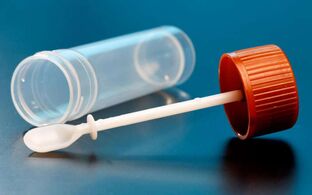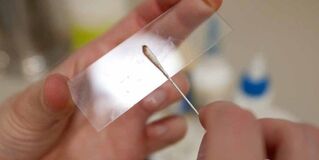What tests should be performed to identify worms?
Worms should be tested regularly to identify the disease in a timely manner. The most famous of these is the analysis of feces, which is done before going to work or a sanatorium trip, but it is not the only and not the most reliable method to identify parasites. The most accurate answer is given by the combination of tests.
What worm tests exist
The list of tests needed to identify parasites is quite long.
Highlights:
- Stool analysis, also known as worm egg, is the most common method. Advantages - massive use, no need for complex equipment. Minus - inaccuracy;
- ELISA, ie blood test for worms. Advantages - high accuracy. Disadvantages - only explores certain stages of parasite development, other times the result will be questionable;
- Analysis of other biological media (urine, sputum, duodenum, epidermis). Benefits - allows you to identify parasites in localizations that are not accessible to other analyzes. Disadvantages - they cause significant inconvenience to the patient.
The patient is usually prescribed a combination of several tests to identify the parasite. The criterion for recovery is a negative ELISA result and a number of negative results in the biological environment in which the worms were detected.
Analysis of worm egg feces
Most worms live in the gut, so the most common test for worms is a stool test. It is prescribed for routine medical examinations for adults and children before being sent to a sanatorium or children’s camp as part of a health book during hospital treatment. These analyzes are given by people who have been in contact with infected patients who have consumed untested foods and noted the characteristic symptoms of the worms.

It is not necessary to prepare for the analysis, you can collect feces at any time of the day, but the most indicative is the morning feces. The perineum should be washed immediately prior to shipment to avoid urinary contamination and genital discharge.
Feces for worm analysis are collected in a special container. They are sealed and attached with a special spoon to collect the material. To collect the most informative part of the material, a sample should be taken from the middle of a part of the stool. The tank must be filled to about one-third. You must send it to the laboratory on the same day.
In the laboratory, a specialist examines feces under a microscope and identifies worm eggs in it. Most of them have a characteristic shape that allows the exact type of worm to be determined. Based on the results of the analysis, a conclusion is drawn about the absence of oocytes or their presence and type, after which treatment is prescribed.
This is the most common but least accurate worm test. This is because some of the eggs in the tank cannot be eggs, even though there are worms. Therefore, if the patient complains of characteristic symptoms or has come into contact with the source of the infection, 5-6 tests should be performed at 2-3 day intervals. In this case, the probability of detecting parasites increases significantly. Other diagnostic procedures are prescribed along with stool testing.
Leather scraping

This analysis usually complements the stool analysis. The most accurate result is obtained when diagnosing pinworms that lay eggs on the skin surface near the anus. Signs of such analysis include routine examination of children and adults, registration of the child in kindergarten, school, camp or sanatorium, hospital care of children and adults, suspicion of pinworm infection (rectal itching, indigestion, contact with patients). Most often, children suffer from this disease, which explains the name of the worm (child pinworm).
There is no need to prepare for the analysis of worms, you should not wash the perineum - so it is possible to wash the eggs of parasites, you should refrain from bathing or showering the night before. The analysis is performed in the morning. A special film is used that collects the material from the skin of the interglutial fold. The examination is also performed under a microscope. It detects no other helminthiases except pinworms.
Urine Analysis
This test is the least prescribed because parasites almost never inhabit urine. Situations are possible where pinworms are found in the urine analysis, but this indicates a violation of the rules for passing the analysis - parasites and their eggs get into the container from the skin of the perineum. This situation is most common in girls and less common in boys.
But there are still indications for testing. Some tropical parasites live in the kidneys and urinary organs, and these people are “rewarded” by a trip to Asian and African resorts. With the increase in the availability of exotic recreational areas, the spread of parasites not typical of Hungary also increases. For this reason, it is advisable to perform a urine and blood test for the worms after traveling to the resorts.
Types of worms found in urine:
- Trichomonas;
- Distomum haematobium;
- Filaria sanguinis hominis;
- Taqnia echinococcus.
There may also be liver parasites in the urine - echinococcus and flukes.
Sputum Analysis
Many parasites spend all or part of their lives in the lungs. Their symptoms are not typical - catarrhal phenomena develop in the bronchi (inflammation, cough, wheezing). Hemoptysis, pneumonia of unknown origin, and other phenomena from the lungs can be recorded.
Parasites detected by the sputum test:
- Ascaris - they need oxygen at the larval stage;
- Echinococci and alveococci are tissue parasites that live in parenchymal organs, including the lungs;
- Dwarf fluke - lives mainly in the lungs;
- Strongyloidosis, noncatorosis - a parasitosis characterized by the localization of the intestine, the location in the lungs is atypical.
Collecting sputum requires no special preparation, but it is recommended to brush your teeth in the morning and take the material away. Before that, it is advisable to drink plenty of fluids - this will improve the expulsion of sputum. The collection container should be clean, but not necessarily sterile - bacteria play no role in the diagnosis. In this case, both parasites and their eggs are detected. If the patient is unable to cough the secretions, they are removed from the trachea by vacuum suction.
It is possible to use drugs that improve sputum release, stimulate the development of more accurate results from worm analysis. Combined with blood tests for worms, it gives very accurate results. Unlike stool testing, oocytes are more likely to be found.
Blood test
 The
TheELISA or blood test for worms is the most accurate way to determine these. Helmamples elicit a strong response from the immune system - an increase in the content of eosinophilic leukocytes, an increase in the production of immunoglobulins, and the appearance of specific antibodies against parasites. The ELISA method is based on their detection.
Antibodies to parasites are highly specific - they can be clearly diagnosed, while they are present in the blood only in the presence of parasites and within 3 weeks of their disappearance.
Venous blood is required for analysis. No special training is required. The result is available within two days. The accuracy is close to 100%, the specificity of the antibodies does not allow an erroneous result. The criterion for recovery is a negative result one month after treatment.
Analyze the contents of the duodenum
The bile ducts and pancreatic ducts open into the duodenum. These organs are often affected by echinococcosis and opisthorchiasis. Parasites lay eggs that enter the intestines through channels. The method of analysis for duodenal worms allows you to identify these diseases much more accurately than the analysis of feces.
The substance is taken on an empty stomach with a duodenal tube. If the patient has a pronounced gag reflex, analgesia is used. The procedure is quite inconvenient, so it is used only in cases where the results of other tests are in doubt.
When to test worms
Worms should be scanned in the following situations:
- The patient has symptoms of helminth infection;
- The patient was associated with sources of infection (patients, untested products, areas with adverse health environments);
- It should be confirmed that the patient is not a source of infection (employment, health records, out-of-town recreation, hospital care).
How to test worms

You should have a referral from your GP to test for worms. Most tests do not require preparation, and if there are shades, your doctor will explain them when prescribing the test. Signals are needed for the doctor to write a referral.
You can perform analysis at commercial clinics regardless of the indication. The price varies significantly. The time to obtain the results of stool and scraping is about one week, the analysis of urine, sputum, blood is about 2 days, depending on the laboratory load.
What helmets can be detected by tests
Analysis of worms allows the identification of most types of parasites - intestinal and extraintestinal forms. The most accurate is a blood test for the worms, which allows the parasite to be identified.
















































